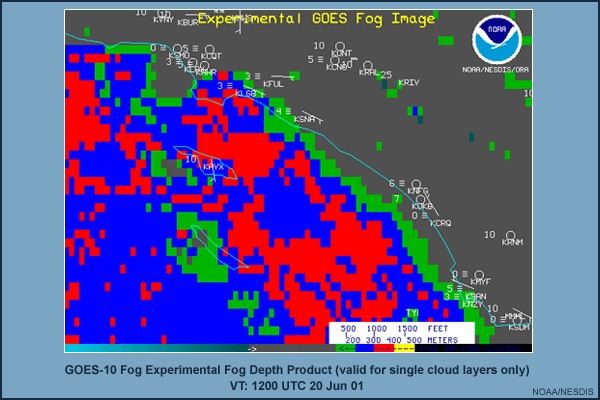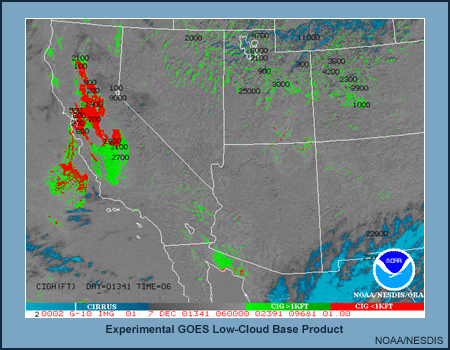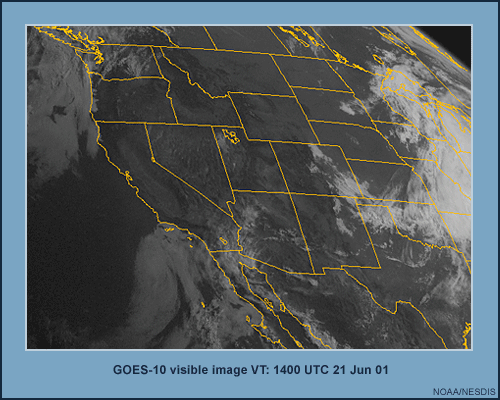Experimental Satellite Products
Important Note: The studies, methodologies and tools presented here are considered experimental and not formally sanctioned by any organization for operational forecast purposes.
Introduction
Satellite imagery has traditionally played an important role in detecting low clouds and fog. Visible imagery and the more recent development of the shortwave infrared channel and derived fog products that provide assistance in distinguishing fog and low cloud at night have enhanced the capability of detecting and forecasting these features.
Here we discuss three tools currently being developed by NESDIS that are intended to further improve the usefulness of satellite imagery:
- Fog Depth Satellite Product
- Low Cloud Base (LCB) Satellite Product
- Shortwave IR Reflectivity product
1. Fog Depth Satellite Product
Overview
The experimental fog depth displayed in the color enhanced image (below) is an estimate of the cloud layer thickness based on the IR brightness difference between GOES channel 2 (3.9 micrometers) and channel 4 (10.7 micrometers). It is valid for single cloud layers only, preferably for radiation or advection fog, prior to sunrise. The image below indicates a large area of fog along and off the southern California coast, ranging in depth from about 500 to 1200 ft.

The color enhancement is based on a linear regression of cloud thickness determined from aircraft pilot reports and surface reports versus GOES dual channel brightness differences within about 50 miles of the aircraft reports and based on a dependent data set collected from 1992-93 using GOES-7 data. A required condition was that fog had to be observed at the surface with visibilities 1/2 mile or less.
Experimental products and further product explanation are available on the NESDIS Website.
2. Low Cloud Base Product
Overview
An experimental Low Cloud Base (LCB) product helps to identify ceilings < 1000 ft for aviation users. The "Fog Depth" image is a special enhancement that estimates the thickness of a low cloud layer, based on the temperature difference between the two IR channels. The red areas indicate cloud bases lower than 1000 ft, while the green areas denote bases greater than or equal to 1000 ft. Blue regions denote cirrus. Observed ceiling heights are overlaid in black.

Experimental products and further product explanation are available on the NESDIS Website.
Status
The date that this product will be officially operational is not yet known. In the meantime, you can access it through the NESDIS Website. Verification of the product has been completed for all regions of the continental United States. The probability of detection (for ceilings < 1000 ft) is about 70%, with a false alarm rate of about 10%, based on more than 1500 cases. See the article in the June 2002 (completed June 2003) NWA Digest (Vol. 26, nos. 1, 2, pp. 39-44) by Gary Ellrod, "Estimation of Low Cloud Base Heights at Night from Satellite Infrared and Surface Temperature Data."
3. Shortwave IR Reflectivity Product
Overview
The GOES-8/9 daytime stratus/fog product is based on a combination of raw data obtained from the GOES shortwave (3.9-micrometer) and longwave (10.7-micrometer) IR imager channels. This product is designed to enhance the difference between these two channels by isolating the solar reflectance contribution at 3.9 micrometers and removing the emitted component. This process discriminates between clouds that contain water and those that contain ice and snow crystals. Imagery from this product can highlight areas of water clouds that may be fog or stratus.
This product can be used during the daytime hours and is ideal for looping sequential GOES-8/9 data and creating a daytime stratus/fog product, as shown in the animation. This is a good example of the GOES-8/9 3.9-micrometer reflectance product combined with the fog product in sequence. Note the transition from the nighttime fog product to the daytime reflectivity product moves east to west with the rising sun. Fog appears white and cirrus appears dark on the nighttime fog product. The speckled areas over the plains indicate deep convection and multilayered clouds.
As the sequence transitions to the daytime reflectivity product, note how the lower clouds become brighter white and the higher ice clouds are lighter and take on a light gray appearance. However, non-cloud reflective areas are also processed in this scheme, and also appear bright white, so the visible image should be viewed (shown below) to properly distinguish these reflective surfaces from the cloud.

Status
Currently, the Reflectivity Product is an experimental product undergoing testing and evaluation.
Regional Application
The applications of this product include the abilities to:
- Discriminate between water clouds versus ice and snow crystal clouds
- Highlight areas of water clouds that may be fog or stratus
- Excellent ability to distinguish cloud from snow cover during the daytime
Limitations / Advantages
As with any product derived from the 3.9-micrometer channel, it is noisy at very cold temperatures. It also is not useful during the night.
Looping from the low cloud product at night to the reflectivity product during the day provides a much smoother transition than looping from the nighttime low cloud product to a daytime visible image. With the low cloud product and reflectivity product pairing during nighttime-to-daytime looping, the low clouds appear similar in both products and allow for more accurate analysis and tracking of low cloud features